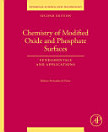S-scheme Heterojunction Photocatalysts: Fundamentals and Applications
Jiaguo Yu · Liuyang Zhang · Linxi Wang · Bicheng Zhu
2023년 6월 · Interface Science and Technology 35권 · Elsevier
eBook
304
페이지
family_home
적용 가능
info
report검증되지 않은 평점과 리뷰입니다. 자세히 알아보기
eBook 정보
S-scheme Heterojunction Photocatalysts Fundamentals and Applications clearly describes photocatalytic processes and mechanisms, reviews the history of traditional heterojunction, discusses the problems of charge transfer in some heterojunctions, states the necessity in proposing S-scheme photocatalyst, and provides, in detail, the design principles and characterization protocols for the emerging S-scheme heterojunction. Examples of S-scheme heterojunctions classified by material types are summarized, and the book provides a comprehensive discussion on design, fabrication, principle, mechanism, characterization, and application of S-scheme heterojunction photocatalyst. This book provides state-of-art research frontiers in this area that will appeal to experienced researchers and graduate students, as well as research and development scientists in the nanosized-composite-related industry. - Provides the latest advances in this topic area, offering insights into the materials and applications of the hybrid materials - Helps distinguish correct explanations from invalid ones and clears up historical misunderstandings in the field - Provides new perspectives in charge carrier migration - Enlightens readers to help them design and develop novel photocatalysts of their own with improved efficiency
저자 정보
Professor Jiaguo Yu received his BS and MS degrees in Chemistry from Central China Normal University and Xi'an Jiaotong University, respectively, and his PhD degree in materials science in 2000 from Wuhan University of Technology. In 2000, he became a Professor at Wuhan University of Technology. He was a postdoctoral fellow at the Chinese University of Hong Kong from 2001 to 2004, a visiting scientist from 2005 to 2006 at the University of Bristol, and a visiting scholar from 2007 to 2008 at University of Texas at Austin. He has won world renown due to his great accomplishments in scientific research by publishing over 600 high-impact SCI papers (149 highly cited ones) and five books, obtaining an H-index of 171. He is a Member of Academia Europaea (2020), a Fellow of the European Academy of Sciences (2020) and a Fellow of Royal Society of Chemistry (2015). He is also one of the 30 Highly Cited Researchers from Clarivate Analytics in three disciplines, i.e. Materials Science, Chemistry and Engineering from 2014 to 2022 worldwide, and the Thomson Reuters "Hottest Researcher" of 2012 in the world.Professor Liuyang Zhang received her Bachelor of Science degree (2012) from Shanghai Jiao Tong University. Subsequently, she received her Ph.D degree in Materials Science and Engineering from National University of Singapore (NUS) in 2016. She worked as Research Fellow in NUS before joining the State Key Laboratory of Advanced Technology for Materials Synthesis and Processing at Wuhan University of Technology as an associate professor. She has been a professor at China University of Geosciences since 2021. Her main research background lies in the area of photocatalysis and electrochemical energy storage. She has published more than 90 SCI papers and edited one book. She was chosen as one of the Highly Cited Researchers from Clarivate Analytics in 2022.Linxi Wang received his Bachelor of Science degree (2013) from Wuhan University, PR China, Master of Engineering degree (2015) from Cornell University, USA, and Ph.D. degree (2020) from the Pennsylvania State University, USA. Currently, he is a postdoctoral fellow in Prof. Jiaguo Yu's group at the China University of Geosciences, PR China. His research interests are the design and fabrication of novel photocatalysts for H2O2 production and water splitting.Bicheng Zhu is an associate professor at China University of Geosciences (Wuhan), PR China. He received his bachelor and doctor degrees in materials science from Wuhan University of Technology. His current research focuses on the synthesis, photocatalytic activity, and first-principles investigation of g-C3N4-based photocatalyst.
이 eBook 평가
의견을 알려주세요.
읽기 정보
스마트폰 및 태블릿
노트북 및 컴퓨터
컴퓨터의 웹브라우저를 사용하여 Google Play에서 구매한 오디오북을 들을 수 있습니다.
eReader 및 기타 기기
Kobo eReader 등의 eBook 리더기에서 읽으려면 파일을 다운로드하여 기기로 전송해야 합니다. 지원되는 eBook 리더기로 파일을 전송하려면 고객센터에서 자세한 안내를 따르세요.









